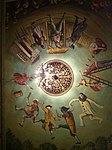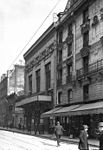République (Paris Métro)
Paris Métro line 11Paris Métro line 3Paris Métro line 5Paris Métro line 8Paris Métro line 9 ... and 4 more
Paris Métro stations in the 10th arrondissement of ParisParis Métro stations in the 11th arrondissement of ParisParis Métro stations in the 3rd arrondissement of ParisRailway stations in France opened in 1904

République (French pronunciation: [ʁepyblik] (listen)) is a station on Lines 3, 5, 8, 9 and 11 of the Paris Métro. It is located under the Place de la République, at the tripoint border of the 3rd, 10th and 11th arrondissements. It is an important interchange station; its 16.6 million users (2019) make it the seventh busiest out of 302 on the Métro network.
Excerpt from the Wikipedia article République (Paris Métro) (License: CC BY-SA 3.0, Authors, Images).République (Paris Métro)
Place de la République, Paris 10th Arrondissement (Paris)
Geographical coordinates (GPS) Address Website Nearby Places Show on map
Geographical coordinates (GPS)
| Latitude | Longitude |
|---|---|
| N 48.867503 ° | E 2.363811 ° |
Address
Place de la République
Place de la République
75010 Paris, 10th Arrondissement (Paris)
Ile-de-France, France
Open on Google Maps










